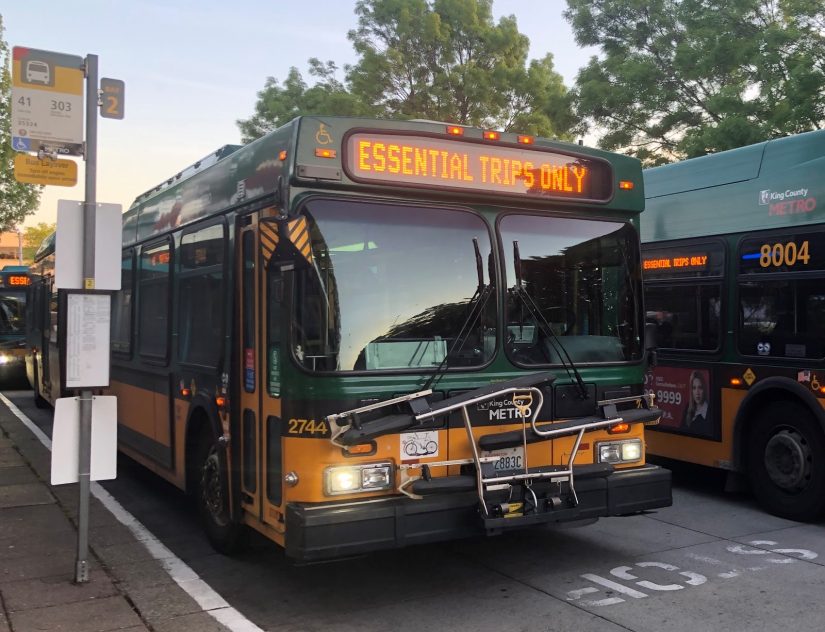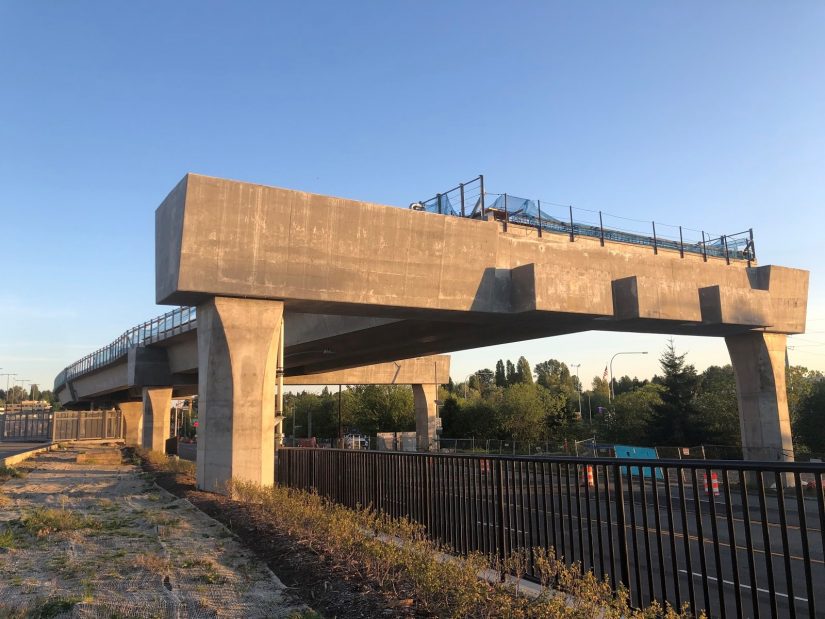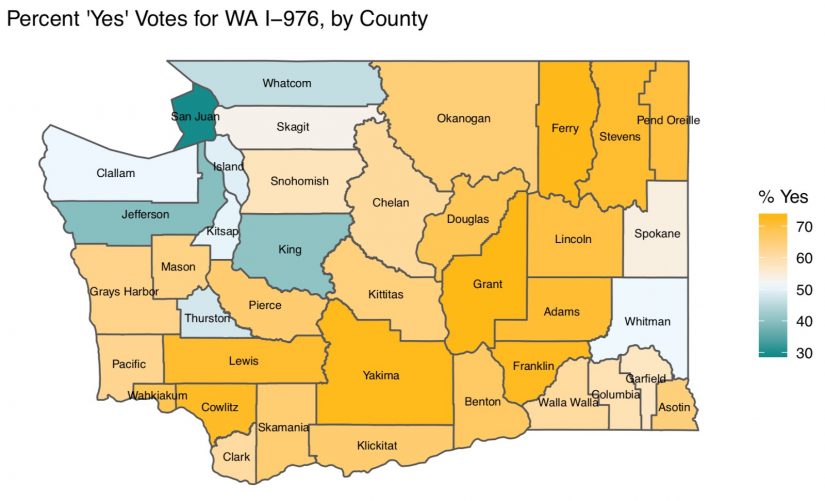When the Details Matter: A Tale of I-976
There’s something subliminally beautiful about public transportation. The coordination of ferries, buses, light rails, and trains is like an unending orchestral score, with a grand conductor making sure all the instruments stay on beat and in tune. For most of us, the intention behind this coordination is beyond our daily thought. We don’t think about the multi-decadal planning behind effective public transit. Intention, however, is how we can transition into a more equitable and climate friendly future; and this requires funding.
Unfortunately, public transit funding in Washington state is currently under siege. As Washington voters may recall, Initiative 976, “Limits on Motor Vehicle Taxes and Fees Measure” (2019), was on the ballot in November. Colloquially dubbed ‘the $30 car-tab Initiative’ by initiative sponsor Tim Eyman, I-976 is almost exactly that – it puts a $30 cap on the yearly car registration fees that WA car owners pay. At first blush this cap seems appealing because it keeps cash in the pockets of WA drivers. However, it also quietly guts the state’s public transit systems by vaporizing a large percentage of transit authorities’ funding sources, specifically the Motor Vehicle Excise Tax (MVET) and Rental Car Tax. I-976 was approved during the 2019 general election by about 3 points, and was set to take effect one month later. That did not happen; I-976 was nearly immediately taken to court by a suite of plaintiffs on the grounds of being unconstitutional by violating the single subject rule, misleading voters, not disclosing all articles to voters, and overriding past local election results. King County Superior Court granted an injunction, barring the initiative from taking effect. Since then, I-976 has remained in the courts. Most recently, Washington State Supreme Court has taken up the case, bypassing the court of appeals. A final decision is expected this summer.
If the court decides that the initiative is constitutional, the initiative will unfortunately take effect in synchrony with the Covid-19 pandemic. Riders are (responsibly) thwarting the virus by staying home; King County Metro ridership has diminished by ~73% compared to a year ago, and travel is restricted to essential trips only. Simultaneously, many local transit authorities are protecting driver safety by waiving fares and only operating buses’ back doors, which are distant from both the farebox and the driver. These necessary precautions unfortunately mean that local transit agencies are indefinitely losing a critical revenue source. The CARES act will provide a financial stimulus to public transit agencies across the nation, but the amount provided might not be able to fully counter the pandemic’s lasting impacts.

Especially now, transit agencies are relying on other streams of revenue to stay afloat. For Sound Transit, voter-approved motor vehicle excise taxes (MVET), rental car taxes, property taxes, and sales and use taxes are the revenue underpinnings that allow for debt repayment and keep transit operating and expanding. If I-976 is found to be constitutional and takes effect, MVET from local taxpayers and rental car tax revenue streams will disappear; Sound Transit projects this loss will be $7.2 billion through 2041. Because planned projects not yet under contract will be delayed to be financed through other tax streams, inflation and interest costs will require an additional $25 billion (through 2061) from local taxpayers. I-976 won’t just gut public transit budgets in metropolitan areas like Seattle, though. It will also hurt the transit authorities and transit dependent in less populous and conservative counties. In Pomeroy, Garfield County, an elderly population depends on public transit for trips like medical transportation; the Mayor worries that “I-976 might mean the end of public transit in Garfield County.”

Gouging funding for public transit, and therefore reducing the quality and quantity of service, will inevitably increase the number of private vehicles on WA roads and aid the beast that is climate change. Rapid population growth in the Puget Sound region is expected to continue, and if public transit options are not financially authorized to keep pace, traffic congestion will continue to worsen. Sound Transit’s planned expansions aims to combat both traffic congestion and carbon emissions by expanding transit options; the previously voter-approved Sound Transit 3 plan projected that “annual vehicle miles driven in the region by 2040 are projected to reduce by 314-411 million miles as people shift from driving to transit.” Current operations already displace approximately 79,000 metric tons of CO2 equivalent per year (solely through the transition from driving to riding), and future shifts in transit modes will further reduce carbon emissions. Reducing carbon emissions is absolutely necessary for curbing climate change and slowing the well documented impacts to our beloved coastal and marine ecosystems.
As resolutions like the Green New Deal address, the conversation and actions surrounding carbon emissions reduction cannot be detached from the conversation and actions that address systemic injustices. When expanding regional public transit systems, planning needs to be built on a foundation of social equity, since public transit systems have the potential to either reinforce existing patterns of social inequalities or alternatively, create conditions that enable prosperity for those typically left behind. Seattle has taken small steps towards creating more equitable conditions by cutting fares for low-income riders and building affordable housing next to light rail stations. Public transit expansion grounded within social equity has the power to reduce the need for cars while curbing existing inequalities.

The map above, which shows the percent support for I-976 by county, shows a fairly clear dichotomy across the state. There is a sash of yellow from the northeast to the southwest corners, showing the ~70% support that counties like Yakima County and Ferry County presented at the polls. If the ballot explicitly stated the implications of the initiative, we could possibly conclude that lifestyles and values towards taxes and public transit are divergent across the state. But in this case, what can we actually glean from this map? After rereading the initiative’s ballot text and the full text, I find the wording to be unclear and not divulgent of all initiative implications; I don’t think we can deduce much from this map. If voters can’t understand the text of the initiative, the map could mean something else entirely – it might, for example, show differences in local newspaper voting guides’ translation of measures into layperson language. Or it might show differences in where Tim Eyman dedicated his campaign efforts and preached his own translation of the initiative. Therefore, what happened at the polls last November perhaps has nothing to do with voters’ perceptions of public transit.
Although I’ve asserted that we need to vote down initiatives that undermine funding for public transit, the matter of I-976 is unfortunately not that simple. If what we see on the ballot doesn’t necessarily portray the true intention of the initiative, we are required to delve deeper into the text of each measure, read voter guides, and have conversations about the election with our friends and families. We are required to put research behind casting our ballots and move towards a pattern of active, intentional voting. As other cost-saving but translucent initiatives surface on future ballots, remember that a $30 car-tab is more than meets the eye.